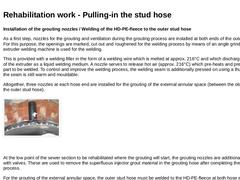
|
Installation of the grouting nozzles / Welding of the HD-PE-fleece to the outer stud hose As a first step, nozzles for the grouting and ventilation during the grouting process are installed at both ends of the outer stud hose. For this purpose, the openings are marked, cut out and roughened for the welding process by means of an angle grinder. An extruder welding machine is used for the welding. This is provided with a welding filler in the form of … |
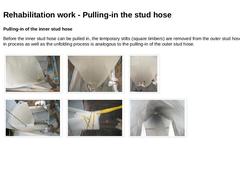
|
Pulling-in of the inner stud hose Before the inner stud hose can be pulled in, the temporary stilts (square timbers) are removed from the outer stud hose. The pulling-in process as well as the unfolding process is analogous to the pulling-in of the outer stud hose. | (Image: Pulling-in of the inner stud hose - view to the pulling head) | (Image: Pulling-in of the inner stud hose - folding the stud hose) | (Image: Pulling-in of the inner stud hose - folding … |
|
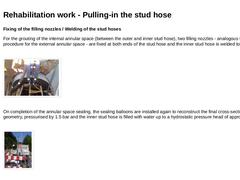
|
Fixing of the filling nozzles / Welding of the stud hoses For the grouting of the internal annular space (between the outer and inner stud hose), two filling nozzles - analogous to the procedure for the external annular space - are fixed at both ends of the stud hose and the inner stud hose is welded to the outer one. (Image: Detail View to the filling nozzles for the grouting of the external (1) and internal (2) annular space) On completion of the … |
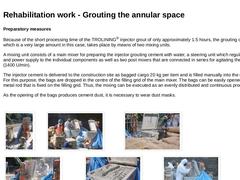
|
Preparatory measures Because of the short processing time of the TROLINING® injector grout of only approximately 1.5 hours, the grouting of the injector, which is a very large amount in this case, takes place by means of two mixing units. A mixing unit consists of a main mixer for preparing the injector grouting cement with water, a steering unit which regulates the water and power supply to the individual components as well as two post mixers that … |
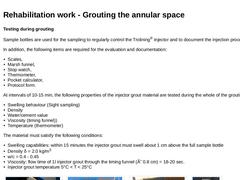
|
Testing during grouting Sample bottles are used for the sampling to regularly control the Trolining® injector and to document the injection processes. In addition, the following items are required for the evaluation and documentation: - Scales,
- Marsh funnel,
- Stop watch,
- Thermometer,
- Pocket calculator,
- Protocol form.
At intervals of 10-15 min, the following properties of the injector grout material are tested during the whole of the grouting process: |
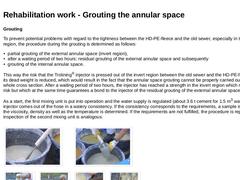
|
Grouting To prevent potential problems with regard to the tightness between the HD-PE-fleece and the old sewer, especially in the invert region, the procedure during the grouting is determined as follows: - partial grouting of the external annular space (invert region),
- after a waiting period of two hours: residual grouting of the external annular space and subsequently
- grouting of the internal annular space.
This way the risk that the Trolining® injector … |
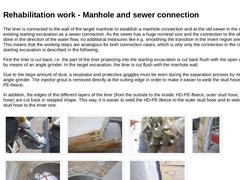
|
The liner is connected to the wall of the target manhole to establish a manhole connection and at the old sewer in the range of the existing starting excavation as a sewer connection. As the sewer has a huge nominal size and the connection to the old sewer is done in the direction of the water flow, no additional measures like e.g. smoothing the transition in the invert region are carried out. This means that the working steps are analogous for both … |
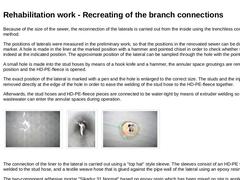
|
Because of the size of the sewer, the reconnection of the laterals is carried out from the inside using the trenchless construction method. The positions of laterals were measured in the preliminary work, so that the positions in the renovated sewer can be drawn by a marker. A hole is made in the liner at the marked position with a hammer and pointed chisel in order to check whether the lateral is indeed at the indicated position. The approximate … |
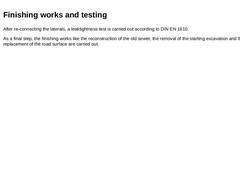
|
After re-connecting the laterals, a leaktightness test is carried out according to DIN EN 1610. As a final step, the finishing works like the reconstruction of the old sewer, the removal of the starting excavation and the replacement of the road surface are carried out. |
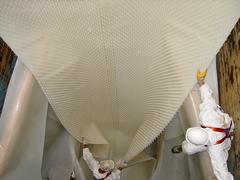
|
Lining of a brick-built sewer with an egg-shaped cross-section DN 2250/1800, with a deflection-resistant annular gap made of load-bearing cement mortar grouting (TROLINING® double system without preliner). Produced by injection behind a plastic inner layer and permanently anchored to the grouting (lining with a rigidly anchored inner plastics layer). |
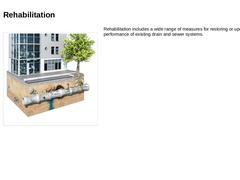
|
(Image: Rehabilitation) Rehabilitation includes a wide range of measures for restoring or upgrading the performance of existing drain and sewer systems. |
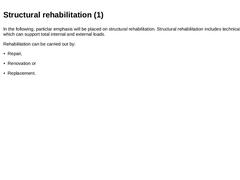
|
In the following, particlar emphasis will be placed on structural rehabilitation. Structural rehabilitation includes technical solutions which can support total internal and external loads. Rehabilitation can be carried out by: -
Repair,
-
Renovation or
-
Replacement.
|
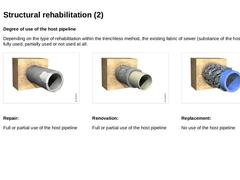
|
Degree of use of the host pipeline Depending on the type of rehabilitation within the trenchless method, the existing fabric of sewer (substance of the host pipeline) is fully used, partially used or not used at all. Repair: Full or partial use of the host pipeline Renovation: Full or partial use of the host pipeline Replacement: No use of the host pipeline |
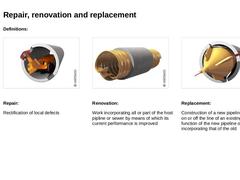
|
Definitions: (Image: Lining with site manufactured pipes) (Image: Replacement by trenchless method) Repair: Rectification of local defects Renovation: Work incorporating all or part of the host pipline or sewer by means of which its current performance is improved Replacement: Construction of a new pipeline or sewer, on or off the line of an existing one, the function of the new pipeline or sewer incorporating that of the old |
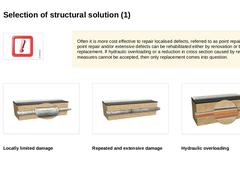
|
Often it is more cost effective to repair localised defects, referred to as point repair. Multiple point repair and/or extensive defects can be rehabilitated either by renovation or by replacement. If hydraulic overloading or a reduction in cross section caused by renovation measures cannot be accepted, then only replacement comes into question. (Image: Locally limited damage) (Image: Repeated and extensive damage) |
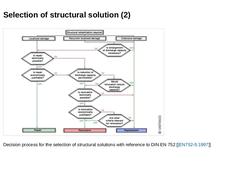
|
(Image: Decision process for the selection of structural solutions with reference to DIN EN 752-5 [DINEN752-5b]) Decision process for the selection of structural solutions with reference to DIN EN 752 [ [EN752-5:1997]] |
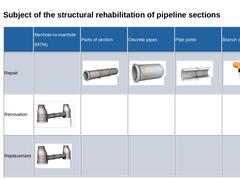
|
|
|
Manhole-to-manhole (MTM) |
Parts of section |
Discrete pipes |
Pipe joints |
Branch connections |
|
Repair |
|
(Image: Parts of section) |
(Image: Discrete pipes) |
(Image: Pipe joints) |
(Image: Branch connections) |
|
Renovation |
(Image: At least one section) |
|
|
|
|
|
Replacement |
(Image: At least one section) |
|
|
|
|
|
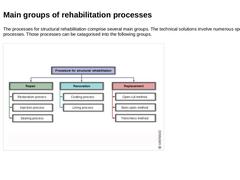
|
The processes for structural rehabilitation comprise several main groups. The technical solutions involve numerous special processes. Those processes can be catagorised into the following groups. (Image: Overview of the main processing groups for the structural rehabilitation of drain and sewer systems) |
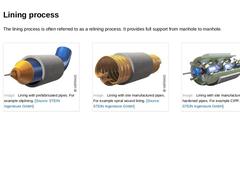
|
The lining process is often referred to as a relining process. It provides full support from manhole to manhole. (Image: Lining with prefabricated pipes) (Image: Lining with site manufactured pipes) (Image: Lining with site manufactured and hardened pipes) |
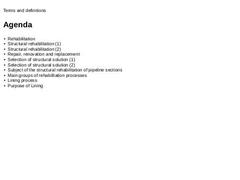
|
|
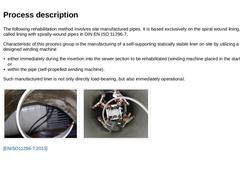
|
The following rehabilitation method involves site manufactured pipes. It is based exclusively on the spiral wound lining, which is also called lining with spirally-wound pipes in EN ISO 11296-7. Characteristic of this process group is the manufacturing of a self-supporting statically stable liner on site by utilizing a specially designed winding machine -
either immediately during the insertion into the sewer section to be rehabilitated (winding machine …
|
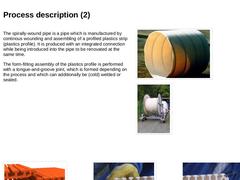
|
The spirally-wound pipe is a pipe which is manufactured by continous wounding and assembling of a profiled plastics strip (plastics profile). It is produced with an integrated connection while being introduced into the pipe to be renovated at the same time. The form-fitting assembly of the plastics profile is performed with a tongue-and-groove joint, which is formed depending on the process and which can additionally be (cold) welded or sealed. |
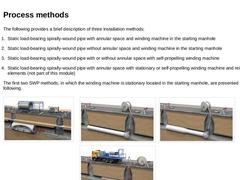
|
|
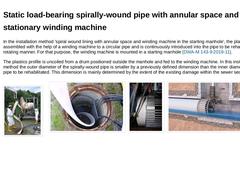
|
|
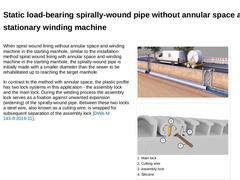
|
|